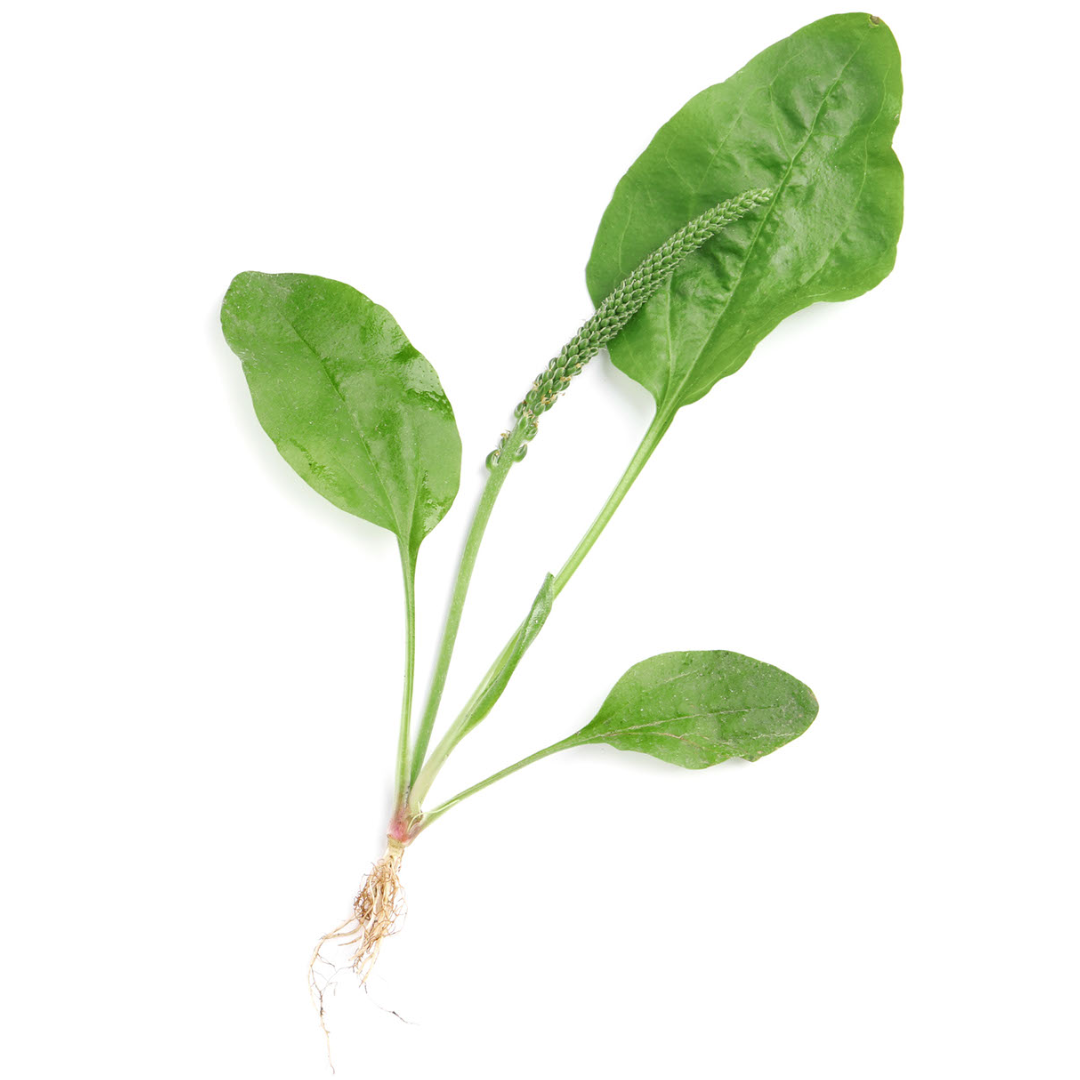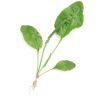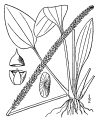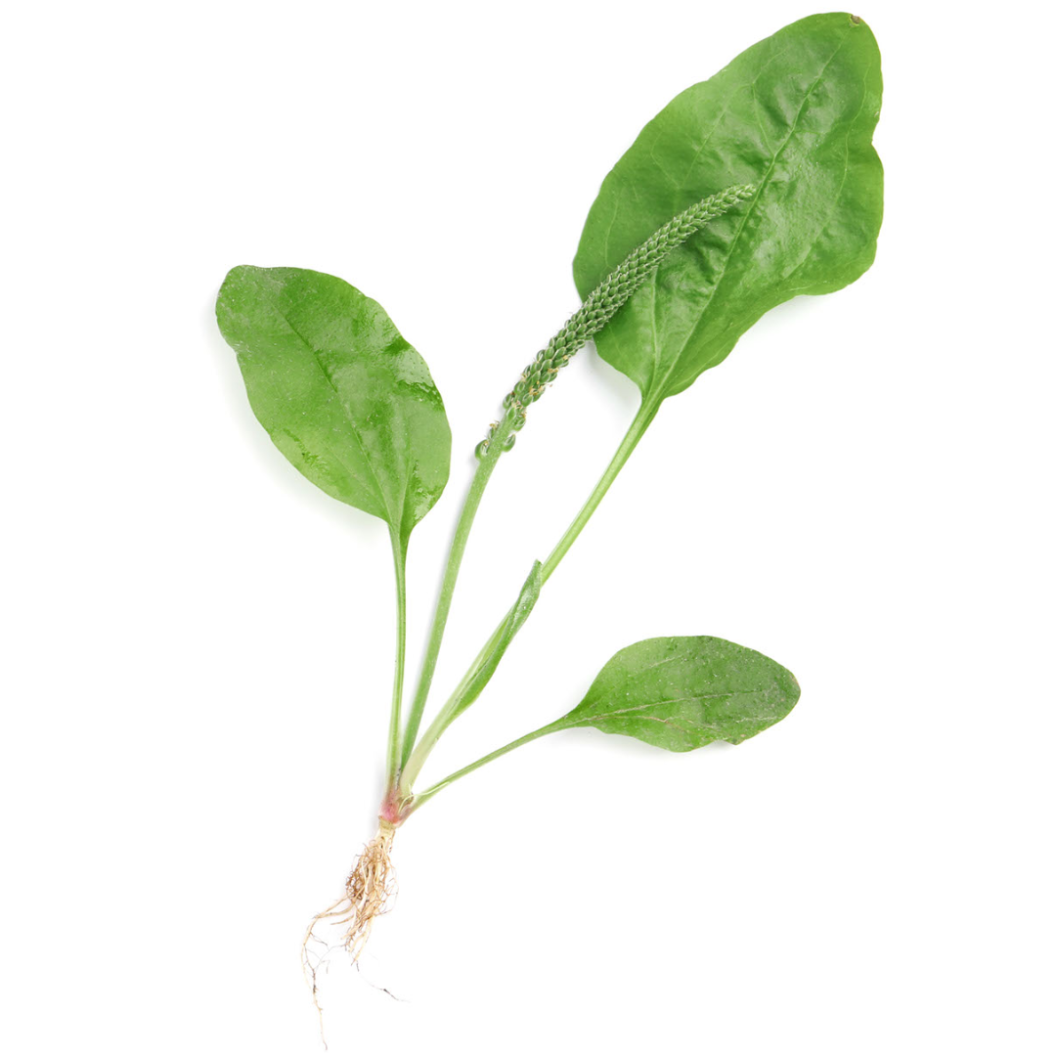





Broadleaf Plantain
DESCRIPTION: Broadleaf Plantian is a common herbaceous plant. The plant is often considered a weed, but it has a long history of use in traditional medicine as a natural remedy for many common ailments, including skin irritations, respiratory issues, and digestive problems. It is also a popular food source for animals like deer and rabbits. The flowers of the Broadleaf Plantain are bisexual, meaning they contain both male and female reproductive organs, and are pollinated by either wind or insects.
SCIENTIFIC NAME: Plantago major
OTHER NAMES: Broad-leaved Plantain
LEAF TYPE: Broadleaf
FLOWERS: Flowers are small and inconspicuous, growing on a long, slender stalk that rises above the plant's leaves. They are arranged in a dense, cylindrical cluster at the top of the stalk and will have a greenish-brown color. They will typically bloom from late spring to early autumn, depending on the climate and growing conditions.
LEAVES: The leaves are its most distinct feature. They are broad, oval-shaped, and can grow up to 8 inches long and 6 inches wide. They will be dark green in color with a smooth, waxy texture. They grow in a rosette pattern at the base of the plant. Leaves have prominent veins that run parallel to the edges giving them a ribbed appearance. Edges are slightly wavy or toothed.
LIFE CYCLE: Perennial
HOW TO IDENTIFY: The easiest way to identify is by the basal rosette of broad, oval shaped leaves with prominent parallel veins and slightly wavy or toothed edges. Also look for a tall, slender stalk with a dense cylindrical cluster of small, inconspicuous greenish-brown flowers at the top.
MECHANICAL CONTROL RECOMMENDATIONS:
1. Hand pulling - More Info
2. Mowing - More Info
3. Cultivation - More Info
4. Mulching - More Info
5. Weed Barriers - More Info
6. Propane Weed Torch - More Info
7. Herbicidal Soap - More Info
8. Boiling Water - More Info
It's essential to remember that mechanical control alone may not entirely eliminate Poa annua, especially in areas where the grass is actively managed, like golf courses and sports fields. Combining mechanical methods with chemical control and cultural practices can offer more effective long-term management. Always follow best practices and local regulations when using herbicides or pesticides. For large-scale control efforts, it's a good idea to consult with a professional turfgrass manager or horticulturist.
CHEMISTRY RECOMMENDATIONS:
"Pre-emergent herbicides:
Prodiamine: This is a popular pre-emergent herbicide that provides long-lasting control against a variety of weeds, including Plantago major
Dithiopyr: Dithiopyr is another effective pre-emergent herbicide that can be used to control Plantago major
Isoxaben: Isoxaben is a selective pre-emergent herbicide that works by inhibiting cell wall synthesis in germinating weed seeds
Oxadiazon: Oxadiazon is a pre-emergent herbicide that offers broad-spectrum control against various weeds, including Plantago major
Pendimethalin: Pendimethalin is commonly used for controlling a wide range of annual grasses and broadleaf weeds, including Plantago major
Benefin + Trifluralin: This combination of pre-emergent herbicides can provide effective control against Plantago major and other weeds
Post-emergent herbicides:
2,4-D: 2,4-D is a widely used herbicide that targets broadleaf weeds like Plantago major
Dicamba: Dicamba is another broadleaf herbicide commonly used for post-emergent control of weeds like Plantago major
MCPA: MCPA is a selective herbicide that targets broadleaf weeds, including Plantago major
Triclopyr: Triclopyr is effective against a wide range of broadleaf weeds, including Plantago major
Clopyralid: Clopyralid is a specialty herbicide that targets broadleaf weeds
Sulfentrazone: Sulfentrazone is a post-emergent herbicide that provides control over broadleaf and grassy weeds
Quinclorac: Quinclorac is effective against a variety of broadleaf weeds, including Plantago major
Carfentrazone: Carfentrazone is a fast-acting herbicide that works on a range of broadleaf weeds
Selective herbicides:
2,4-D: This is one of the most widely used selective herbicides for controlling broadleaf weeds, including Plantago major.
Dicamba: Dicamba is another effective selective herbicide that targets broadleaf weeds.
MCPA: MCPA is commonly used to control broadleaf weeds in lawns and turfgrass areas.
Triclopyr: Triclopyr is effective against a range of broadleaf weeds, making it a suitable choice for controlling Plantago major.
Clopyralid: Clopyralid is known for its effectiveness against tough broadleaf weeds, including Plantago major.
Aminopyralid: Aminopyralid is a relatively newer selective herbicide that targets broadleaf weeds.
Quinclorac: Quinclorac is particularly effective against young broadleaf weeds and is often used to control weeds like Plantago major in turfgrass areas.
Fluroxypyr: Fluroxypyr is a selective herbicide used to control a variety of broadleaf weeds, including Plantago major.
Non-Selective herbicides:
Glyphosate: Glyphosate is one of the most widely used non-selective herbicides.
Glufosinate: Glufosinate is another non-selective herbicide that can be effective against Plantago major.
Paraquat: Paraquat is a fast-acting non-selective herbicide that can be used to control Plantago major.
Diquat: Diquat is a contact herbicide that can desiccate and kill Plantago major.
Pelargonic acid: This is a natural fatty acid-based herbicide that can be used as a non-selective option for controlling weeds like Plantago major.
Acetic acid (vinegar): Household vinegar with high acetic acid content can be used as a non-selective herbicide. "
Recommended Prevention
Recommended Control

